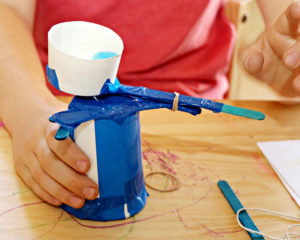Why I teach it to elementary school students:
My least favorite words to hear as a teacher are “I’m bored.” It is very tempting as an adult to try to alleviate that short-term discomfort by rattling off a series of suggestions, but I’ve learned over time to think more proactively about how to promote a creative problem-solving mindset. This activity, which I learned about on the website childhood101.com, is wonderful because it sets an end goal for children but does not prescribe a formula for reaching that goal. That job is theirs.
What you need:
The other nice thing about offering this activity at this point in time is that because it’s open-ended, not having some suggested materials immediately available is fine. For example, while this is technically called a pom pom launcher, you may find other small, lightweight materials more accessible; marshmallows, cotton balls, even a crumpled foil ball.
For the launcher itself, you might try: index cards, paper cups, straws, popsicle sticks, elastics, string, cardboard tubes
Tools:
These could include scissors, tape, a hole punch, a stapler
Procedure:
Tell your child that the goal is to create something that will throw your object from one place to another. Or take a step further back and suggest that your child create something using some or all of the materials and see what he or she comes up with.
Talking about children’s design projects and art:
As a teacher I frequently find that children will ask me or other adults some variation of the question: “Is this good?” It can be helpful to initiate a dialogue about children’s projects by not answering this question directly but instead commenting on what you notice, find interesting, or are curious about either while they are working or after they have finished a project. I try to be proactive about this by offering observations out loud as children are working, which I find increases the degree to which children proactively share their observations as they work.
Try it out:
I suggest making the materials to be launched available from the outset of the project and encouraging children to try it out as they work. If children struggle and get frustrated when a design doesn’t work it can be helpful to direct their attention to a particular part that needs to be shored up, starting the conversation from a point of observation: “I noticed that this part seems to be too loose; I wonder what materials might help strengthen it.” If your child gets invested in this project, you could also help them set some goals (multiple markers of distance) so that after a successful launch you can reassess together: “I wonder what you can change to launch a pom pom twice as far.” Have fun and gently stretch children’s boundaries if their interest is sparked.

Activity by Robbie Hartery, Sprague Site
Photo Credit: www.childhood101.com
